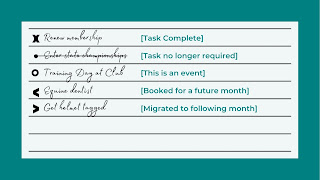Do you ever struggle to remember the details of your last training session, competition results, or vet visits? Keeping an equestrian bullet journal (Equi BuJo) makes tracking your horse's progress easy and efficient!
A bullet journal dedicated to 'all things horse' helps you stay organised while being time-efficient and budget-friendly. It's far more reliable than memory alone and gives you a structured way to reflect on past experiences and plan for future success.
What’s a Bullet Journal?
The bullet journal (BuJo) method, created by Ryder Carroll, is a system to track your past, organise your present and plan your future. It is a brilliant combination of planner, diary, notebook and to-do list that can be adapted to any aspect of life - including your equestrian journey.
The Equi BuJo is a modified version of the traditional bullet journal, streamlined specifically for horse riders and owners.
Materials needed
Notebook (any size with minimum 31 lines)
Pen
Ruler
Helpful Hint:
If your notepad does not come with ribbon to bookmark pages, tie ribbon to the spine of a spiral notebook. For notepads without spirals, a paperclip can be used to mark the current important section (monthly schedule) for quick reference.
Watch this short video demonstrating the initial setup of an Equi BuJo:
Basic Outline of Equi BuJo
Index
Yearly Schedule
Monthly Schedule
Monthly Tasks/Focus
Monthly Rides
Custom Collections
What is a Collection?
The core collections include the index, yearly schedule, monthly schedule, monthly tasks/focus and monthly rides.
Custom collections can be added as needed and recorded in the index for easy reference.
Some ideas for collections include:
Goals - long term goals and tactics to achieve them.
Venue PIC numbers - if you travel your horse within Australia.
Horse Movement Record - as per Australian biosecurity requirements.
Horse Health Record - log vet visits, deworming and vaccinations.
Clinic/lesson notes - record key takeaways from trainers and coaches.
Book/video notes - summarise insights from educational resources.
Training exercises - record exercises you want to recall later.
Adding Pages to Collections
When adding pages to a collection topic at a later date, simply start a fresh page and write the new page number/s beside the relevant topic in the index, separating previous entries with commas.
Example
INDEX
Horse Health Record: 7, 31, 90
In this example, you can easily find an ongoing record of your horse’s health on pages 7, 31 and 90.
Key for Monthly Task Lists
For easy management, use these symbols:
. task (new task)
X task complete (cross through the original dot)
> migrated ( moved forward to next month)
< scheduled task (added to yearly schedule)
O event (clinic/competition you have coming up in the current month)
- notes (anything additional you need to note that is not a task)
Example
Notes:
You will migrate tasks you do not complete to the following month.
If a task is no longer relevant, simply put a line through the task.
If the task needs to move to a future month, simply add it to the yearly schedule at the front of the Equi BuJo.
More on the Index
In the video, core collections are recorded separately from custom collections to make scanning monthly schedules easier. Alternatively, you can keep everything on the same index page and use different pen colours to distinguish important topics.
Final thoughts
With an Equi BuJo, you can take control of your equestrian goals, track progress and important records and reflect on your journey - all in the one place.
Have you tried using a bullet journal for your riding? Share your favourite collections in the comments!
You might also like to read:
- Rider Timing at the Walk
- Training Horses with Timing and Feel
- Horse training principles every rider must know for better results
Learn the WHY. Your horse will thank you.
#HeardHorses #learnthewhy #buildbetterbasics #applytheprinciples

.jpg)
